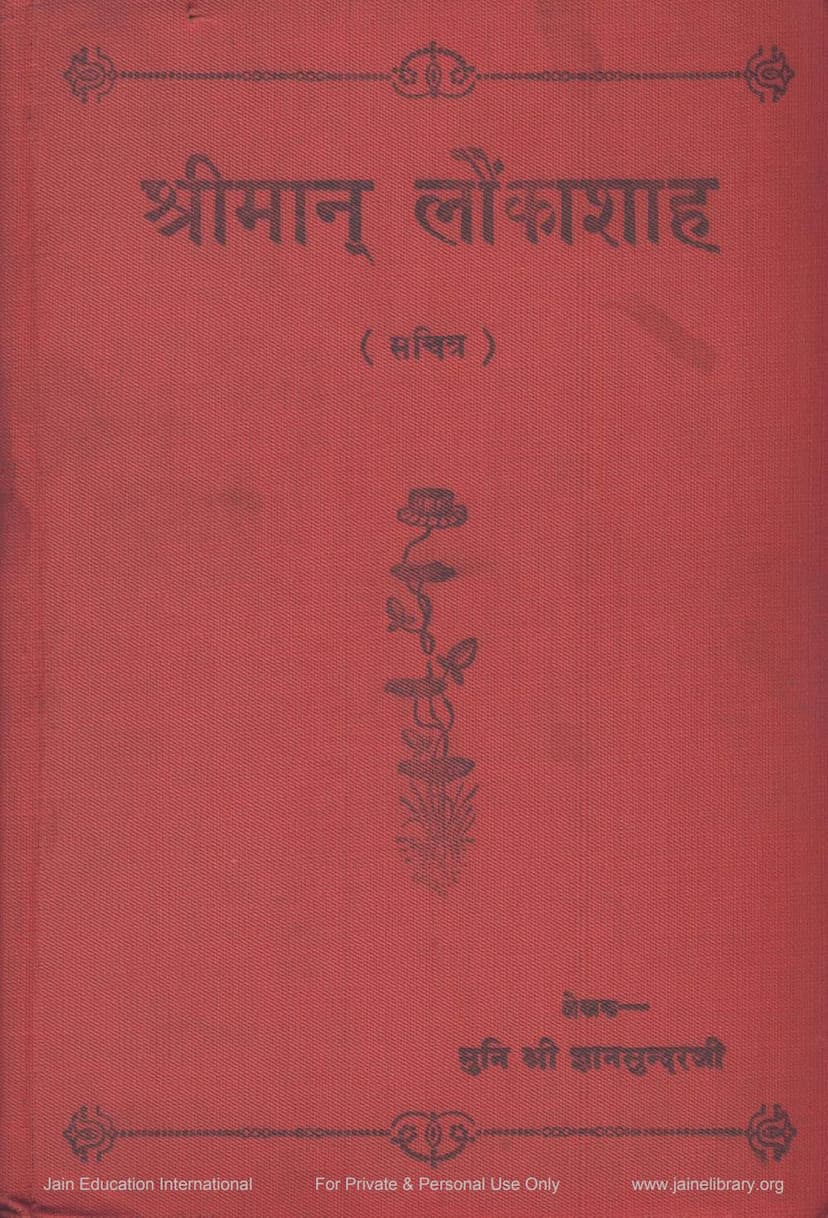Shreeman Lonkashah
Added to library: September 2, 2025

Summary
Here's a comprehensive summary of the provided Jain text, "Shreeman Lonkashah," authored by Muni Gyansundarji Maharaj:
Book Title: Shreeman Lonkashah Author: Muni Shri Gyansundarji Maharaj (of Upkeshgachh) Publisher: Shri Ratna Prabhakar Gyan Pushpmala, Phalodhi (Marwar) Theme: This book aims to shed historical light on the life of Shreeman Lonkashah, presented as a significant figure in Jain history, particularly in relation to the contentious issue of murti-pooja (idol worship) and the emergence of new sects within Jainism.
Summary:
The book is a response to what the author, Muni Gyansundarji Maharaj, perceives as misrepresentations and slanders against revered Jain Acharyas and the practice of murti-pooja by certain individuals, notably Muni Shri Shourtney Chandraji (also known as Sant Balji). Muni Gyansundarji feels compelled to present an accurate historical account to counter these "corrupt thoughts" and "misleading writings."
Key Themes and Arguments:
-
Critique of Opposing Views: The author's primary motivation stems from a series of articles published in the "Jain Prakash" newspaper by Muni Shri Shourtney Chandraji. These articles, titled "Dharmapraan Lonkashah," allegedly insulted Jain Tirthankaras and criticized ancient Acharyas. Muni Gyansundarji expresses his inability to tolerate such attacks, especially when presented as historical analysis, which he believes hurt the sentiments of a vast number of Jain followers.
-
Lonkashah's Historical Context and Impact: The book delves into the historical period of Lonkashah, placing him in the 15th-16th century Vikram Samvat. The author contends that Lonkashah, driven by a sense of insult and possibly influenced by non-Jain cultural elements, challenged established Jain practices. The author argues that Lonkashah's movement, rather than being a reform, caused a schism and decline within the Jain community, ultimately leading to a drastic reduction in Jain numbers.
-
Reinterpretation of Jain History and Acharyas: Muni Gyansundarji directly addresses and refutes the critical views of Lonkashah's impact and the contributions of prominent Acharyas like Acharya Haribhadra Suri and Acharya Hemchandrasuri. The author criticizes the notion that Lonkashah initiated a significant religious revolution that benefited the world, while contrasting this with the established achievements of the aforementioned Acharyas who spread Jain principles and brought many into the fold.
-
Debunking False Claims: The author meticulously examines the claims made by opposing writers, pointing out historical inaccuracies and contradictions. For instance, the author challenges the purported timelines and the anachronistic presence of certain Kshatriya clans in the era of Acharya Ratnaprabhasuri, as presented by critics.
-
The Nature of Lonkashah's Movement: The book aims to clarify who Lonkashah truly was and what his actions entailed. The author argues that Lonkashah's movement was not a genuine spiritual revival but rather a consequence of personal grievances and a misunderstanding of Jain principles. It is presented as a divisive force that weakened the Jain community.
-
The Origin of the Sthanakavasi Sect: The author implicitly links Lonkashah's historical role to the emergence of the Sthanakavasi sect. However, the book posits that the Sthanakavasi sect ultimately became followers of later figures like Yati Lavji and Dharma Singhji, who further deviated from Lonkashah's original, albeit controversial, principles.
-
Emphasis on Evidence and Authenticity: A significant portion of the book is dedicated to presenting and analyzing various historical sources, including pattavalis (genealogies/chronicles of monastic lineages) and ancient Jain texts. The author strives to use evidence from contemporary or near-contemporary sources to establish Lonkashah's timeline, birthplace, occupation, teachings, and eventual demise. The author critically evaluates the conflicting accounts found in different texts, particularly those from the Sthanakavasi tradition, highlighting the lack of concrete evidence for many of their claims.
-
Structure of the Book: The book is structured into numerous chapters and appendices, meticulously detailing various aspects of Lonkashah's life and the historical context. These include:
- Introduction/Preface: Setting the stage for the historical debate.
- Chapters on Lonkashah's Life: Covering his identity, time period, birthplace, occupation, education, principles, impact on Jain society, his alleged writing of scriptures, his relationship with Bhasmagraha (a planetary influence), the reasons for his new sect, his principles, stance on idol worship, and muhpaṭṭi (mouth covering).
- Rebuttals and Analysis: Chapters critically examining the arguments and evidence presented by opposing scholars and refuting their claims with historical and scriptural data.
- Appendices: Including references to various ancient texts, pattavalis, and critiques of other historical accounts, aiming to provide comprehensive substantiation.
Conclusion:
"Shreeman Lonkashah" by Muni Gyansundarji Maharaj is a scholarly and defensive work aimed at correcting historical narratives, particularly concerning Lonkashah's role and the practices of murti-pooja and muhpaṭṭi. The author's intent is to present a historically grounded perspective that supports the established traditions and Acharyas of Jainism, while refuting what he considers to be misinterpretations and slanderous claims originating from certain schismatic movements within the faith. The book emphasizes meticulous research and reliance on ancient textual evidence to establish its arguments.